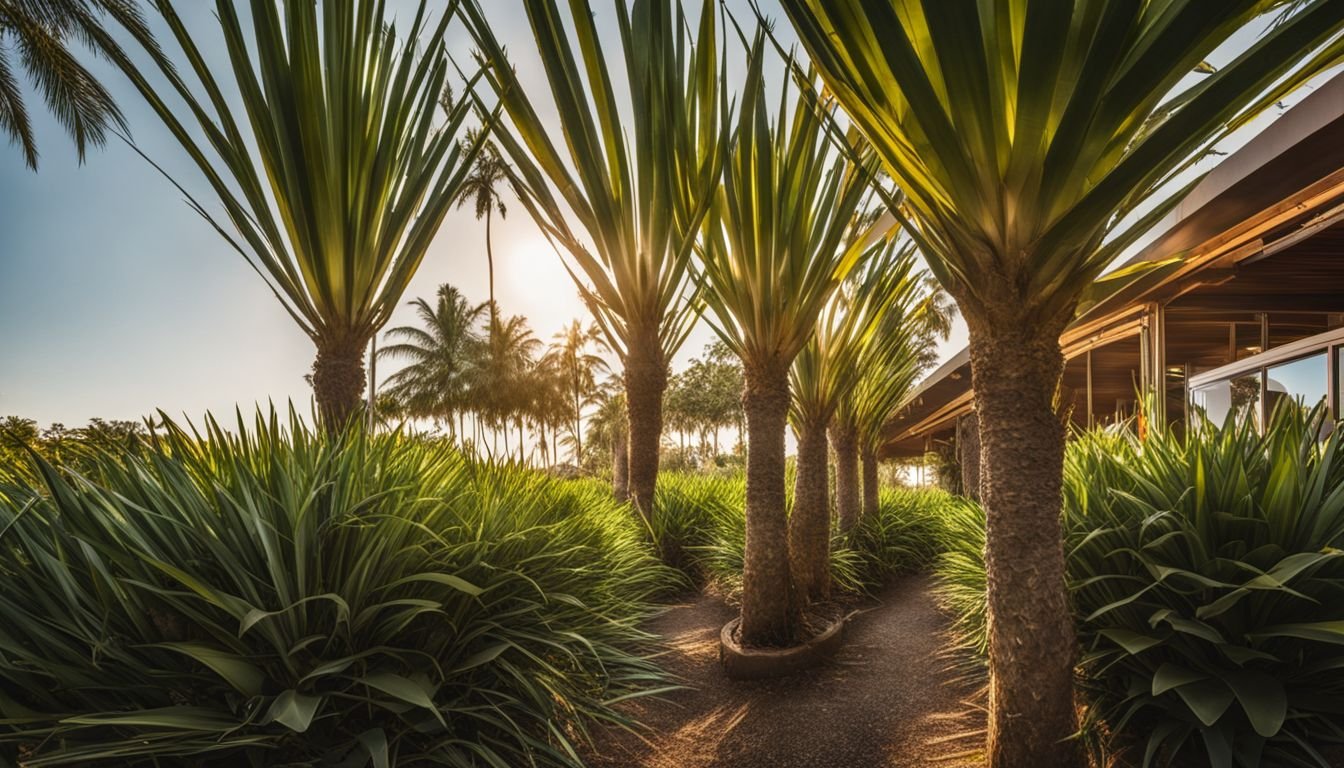Growing Pandanus palms from seeds down under can feel a bit like waiting for a drizzle in the Outback. You’ve got these beauts, right? Native to our coastal dunes – lush green gems that can turn any old backyard into something out of a tropical daydream.
But coaxing those seeds into life? That’s where plenty of us end up scratching our heads, wondering if we’re missing some sort of secret handshake.
We’ve been in the trenches with you, flipping every rock looking for the magic formula to kickstart growth from those enigmatic fruit keys of the Pandanus. Here’s a sparkler for you: nestled within each pandanus fruit key are 1 to 3 seeds, each one bursting with potential but might take them a lazy year to pop open – testing both your patience and dedication.
Through heaps of digging around in research and getting our hands dirty with trials, we’ve pieced together this ripper of a guide stuffed with actionable nuggets—not just on sparking life but ensuring your Pandanus palms flourish from seed.
Be prepared for solid advice on picking the right soil, planting know-how, setting up your watering game plan and fending off those pesky critters—all customised for Aussie growers.
Keen to see those green thumbs at work?
Key Takeaways
- Pick the right soil for your pandanus seeds; they love sandy, well – draining mix with a bit of organic matter mixed in. This helps them set strong roots and grow healthy.
- Planting the seed correctly matters heaps. Don’t bury them too deep in the potting mix – just enough to hold them upright. Keep it moist and wait patiently, as germination can take up to a year.
- Adjust watering based on the season—more during hot summers and reduce in winter to avoid root rot. Regular repotting and pruning after flowering also keep your pandanus palm in top shape.
- Watch out for pests like mealybugs and aphids that attack your plant by sucking sap from its leaves. Also be proactive against conditions leading to dieback by ensuring good drainage and protection from excessive moisture.
- Not only seeds but you can also grow these plants using stilt root cuttings from mature palms, giving you more ways to expand your garden with these unique trees.
Understanding Pandanus Palms

We find Pandanus palms fascinating, not just for their unique appearance but also for their versatility and importance in various cultures. These trees, often called screw pines or screwpalms, stand out with broad canopies and long, green strappy leaves that are perfect for crafting items such as hats, mats, and bags.
Originating from the Old-World tropics and sub-tropics, they have made a significant mark in Australia with around 37 species being endemic to our continent.
Pandanus plants thrive in low-maintenance gardens where they can serve multiple purposes – from coastal defense to providing shade and screening against winds. They demand a frost-free environment and enjoy regular feeding during active growing seasons to reach their full potential.
Unlike many other trees that pose constant challenges with pests and diseases in suburban gardens, pandanus palms are relatively trouble-free which adds to their appeal among Australian garden enthusiasts looking for robust yet attractive landscaping options.
Steps to Successfully Grow Pandanus Palms from Seed

We’ve mastered the techniques to sprout Pandanus palms from seeds, making it easier for you to bring a touch of the Pacific Islands into your Australian garden. Our guide will walk you through each step, ensuring your seed transforms into a thriving Pandanus tree with the right care and attention.
Choosing the Right Soil
Selecting the ideal soil is crucial for the successful growth of Pandanus palms from seeds. These unique plants thrive in well-draining, sandy soil that leans towards a slightly acidic to neutral pH level.
Let’s make sure we use a potting mix specifically designed for palms. This ensures our pandanus seeds have the best start possible, laying down strong roots and fostering healthy growth.
To boost our chances even further, incorporating organic matter like compost or peat moss into the soil can significantly improve its texture and fertility. This step is vital because it helps create an environment where pandanus seeds can germinate effectively and seedlings can prosper.
Keeping the soil consistently moist—but not waterlogged—is key to nurturing these fascinating plants through their initial stages.
Ensuring we follow these guidelines sets up our Pandanus palms for success right from the get-go. With patience and proper care, we’ll watch these magnificent plants grow, adding a touch of subtropical flair to our Australian gardens.
Planting the Pandanus Seeds
We kick off the planting process by filling a pot with a rich, well-draining soil mix. This ensures the pandanus seeds, or keys as they’re commonly called, have the perfect environment to start their growth journey.
It’s crucial not to overcrowd the pot; one to three keys per container strikes the right balance. This gives each seed ample space to thrive without competing for nutrients and sunlight.
Next, we gently push each key into the soil, ensuring it’s snug but not buried too deep—just enough so it stands upright. A consistent watering schedule keeps the soil moist, which is vital for germinating pandanus seeds.
Bear in mind, patience plays a big role here; taking up to 12 months for signs of life isn’t uncommon with these unique plants. During this waiting period, protect your future screw palms from pests and extreme conditions by keeping them in a spot that mimics their natural rainforest habitat — warm and humid yet bright indirect light seals the deal.
Watering and Maintenance
We keep our Pandanus palms thriving by adjusting our watering habits with the seasons. In the hot summer months, they crave lots of water to support their growth. However, come winter, we cut back significantly to prevent root rot from setting in due to excessive moisture.
This delicate balance ensures that these tropical beauties remain healthy year-round.
For maintenance, repotting them annually encourages quick development and provides an opportunity to refresh the potting mixture. After their flowering season concludes, we prune away any damaged or dead branches and stems.
This not only keeps them looking tidy but also helps prevent dieback by removing parts of the plant that could harbour disease or pests like mealybugs and aphids. Regular checks for these pests allow us to act swiftly with horticultural sprays or insecticides before a minor threat turns into a severe problem.
Common Pests and Diseases to Watch Out For
Keeping an eye out for mealybugs and aphids becomes essential as we tend our pandanus plants. These pests, albeit minor threats, can swiftly turn into a nuisance if left unattended.
They suck sap from the leaves, weakening the plant and sometimes spreading diseases. Regular inspections help us spot any infestations early, allowing us to act quickly by washing them off with a hose or applying natural insecticides.
Another concern we’ve noticed is dieback, particularly when our beloved pandanus is exposed to cold and wet conditions for extended periods. This issue often manifests as yellowing leaves that gradually brown and fall off.
Ensuring proper drainage in the soil and protecting the plant from excessive moisture during cooler months are effective strategies to prevent this problem from taking hold. Keeping our plants healthy involves both vigilance against pests like mealybugs and aphids and proactive measures to avoid conditions that lead to dieback.
Frequently Asked Questions about Pandanus Palms
Growing Pandanus palms from seed in Australia intrigues many of us passionate about gardening. Here are some questions we often hear and their answers to guide you.
- How long does it take for Pandanus seeds to germinate?
- Expect patience to be a virtue here, as germination can take up to 12 months. Ensure the seeds stay moist and are kept in a warm, sheltered spot.
- Can I grow Pandanus palms from fruit keys?
- Absolutely! Each key of the pandanus fruit holds 1 to 3 seeds suitable for germination. Just make sure you gently remove the seeds from the key before sowing.
- What soil is best for planting Pandanus seeds?
- Choose a well – draining potting mix rich in organic matter. This provides the right balance of nutrients and moisture for the young plants.
- Are Pandanus palms only grown from seeds?
- Not at all! You can also propagate these trees through stilt root cuttings from a mature pandanus palm, offering another successful method for growing these unique plants.
- Do Pandanus palms require special care?
- They thrive in frost – free environments with plenty of sunlight. During summer, water generously but cut back in winter to prevent rotting roots due to excess moisture.
- What pests or diseases should I watch out for?
- Luckily, pandanus palms aren’t highly susceptible to pests or diseases in suburban gardens. However, watch out for dieback if conditions become too cold and wet.
Additional Reading on Plant Care and Maintenance
Exploring deeper into the world of plant care and maintenance opens up a treasure trove of knowledge beyond just pandanus palms. With our gardens being home to everything from Tasmanian blue gum to macadamia shrubs, understanding the unique needs of each species becomes crucial.
Whether it’s mastering the art of humidity control for your tropical plants or learning how to protect your eucalyptus globulus from pests, there’s always more to learn. We make it our mission to compile reliable resources that help you become not just a gardener but a guardian of nature.
Staying informed about the latest in sustainable gardening practices isn’t just good for your plants; it’s essential for our environment too. From employing water-wise techniques suited to Australia’s temperate regions to using natural methods for controlling common garden pests, every bit helps in creating a healthier planet.
We encourage you to dive into articles and guides focused on these topics, keeping an eye out for those that challenge common misconceptions with data-backed evidence.
Let’s keep nurturing our love for gardening by staying curious and informed. After delving into additional reading on plant care and maintenance, why not share what you’ve learned?.
Conclusion
Growing Pandanus palms from seeds in Australia is quite the adventure. It demands patience and care, but the lush, tropical ambiance they bring to your garden is unparalleled. Remember, successful germination might test your endurance with its lengthy timeline.
Yet, armed with the right knowledge about soil choice, watering practices, and pest prevention, you’ll navigate these challenges like a pro. Let’s transform those gardening goals into reality; it’s time to start planting those pandanus keys!
FAQs
1. What are Pandanus Palms, and where can I find them in Australia?
Pandanus palms, specifically the Pandanus tectorius or common screwpine, are tropical plants known for their stilt roots and woody fruits that resemble pineapples. You can often spot these unique trees along Australia’s coastal regions.
2. Can you grow Pandanus Palms from seeds at home?
Yes, you absolutely can! With patience and the right conditions, growing pandanus trees from seeds is achievable. Start by extracting seeds from ripe pandanus fruits and plant them in a well-draining nursery pot.
3. How long does it take for Pandanus Palms to germinate and grow roots?
Germination times vary, but typically, pandanus seeds start sprouting within a few weeks to a couple of months under optimal conditions. Expect strong root development as they mature.
4. Are there male and female Pandanus flowers? How do they differ?
Indeed, pandanus palms produce separate male and female flowers on different trees. The male flowers emit a sweet fragrance while female flowers eventually develop into the characteristic large fruits or “pineapples”.
5. What kind of care do Pandanuss Palms need to thrive in an Australian garden?
Pandanus palms prefer sunny locations with good air circulation around their stilt roots. They require regular watering during dry spells but ensure proper drainage to prevent root rotting.
